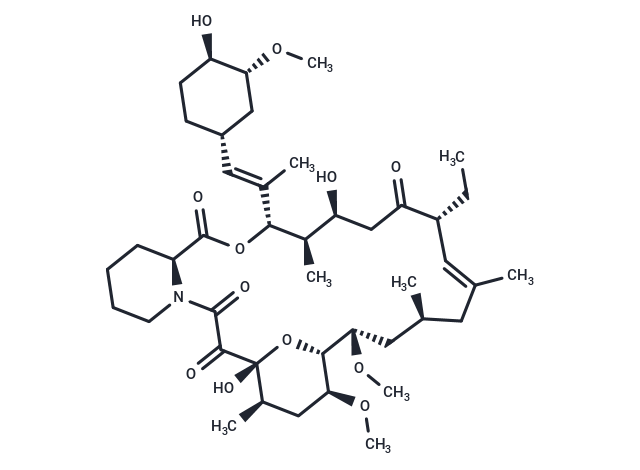Shopping Cart
- Remove All
 Your shopping cart is currently empty
Your shopping cart is currently empty

Ascomycin (Immunomycin)(Immunomycin, FR-900520, FK520) is an ethyl analog of tacrolimus (FK506) with strong immunosuppressant properties.

| Pack Size | Price | Availability | Quantity |
|---|---|---|---|
| 5 mg | $36 | In Stock | |
| 10 mg | $52 | In Stock | |
| 50 mg | $63 | In Stock | |
| 100 mg | $81 | In Stock | |
| 500 mg | $192 | Backorder | |
| 1 mL x 10 mM (in DMSO) | $54 | In Stock |
| Description | Ascomycin (Immunomycin)(Immunomycin, FR-900520, FK520) is an ethyl analog of tacrolimus (FK506) with strong immunosuppressant properties. |
| Targets&IC50 | Calcineurin phosphatase:49 nM |
| In vitro | Intramuscular injection of 3.2 mg/kg Ascomycin significantly prolonged the survival rate of rats with skin transplants. When administered into the rat hippocampus, Ascomycin at concentrations of 50 or 100 μM exhibited anticonvulsant effects against seizures induced by pentylenetetrazol. |
| In vivo | Ascomycin inhibits calcineurin by forming an FKBP12-FK520-calcineurin complex, with an IC50 of 49 nM. Additionally, FK520 accelerates neural regeneration and promotes neurite outgrowth. Ascomycin exhibits antimalarial effects by inhibiting the molecular chaperone activity of a bifunctional protein. Moreover, ascomycin suppresses the in vitro immune response of mixed lymphocytes in mice, with an IC50 of 0.55 nM. |
| Alias | Immunomycin, FR-900520, FK520 |
| Molecular Weight | 792.01 |
| Formula | C43H69NO12 |
| Cas No. | 104987-12-4 |
| Smiles | CC[C@@H]1\C=C(C)\C[C@H](C)C[C@H](OC)[C@H]2O[C@](O)([C@H](C)C[C@@H]2OC)C(=O)C(=O)N2CCCC[C@H]2C(=O)O[C@@H]([C@H](C)[C@@H](O)CC1=O)C(\C)=C\[C@@H]1CC[C@@H](O)[C@@H](C1)OC |
| Relative Density. | 1.19 g/cm3 (Predicted) |
| Storage | Powder: -20°C for 3 years | In solvent: -80°C for 1 year | Shipping with blue ice. | ||||||||||||||||||||||||||||||
| Solubility Information | DMSO: 45 mg/mL (56.82 mM) Ethanol: 39.6 mg/mL (50 mM) | ||||||||||||||||||||||||||||||
Solution Preparation Table | |||||||||||||||||||||||||||||||
Ethanol/DMSO
| |||||||||||||||||||||||||||||||

Copyright © 2015-2024 TargetMol Chemicals Inc. All Rights Reserved.